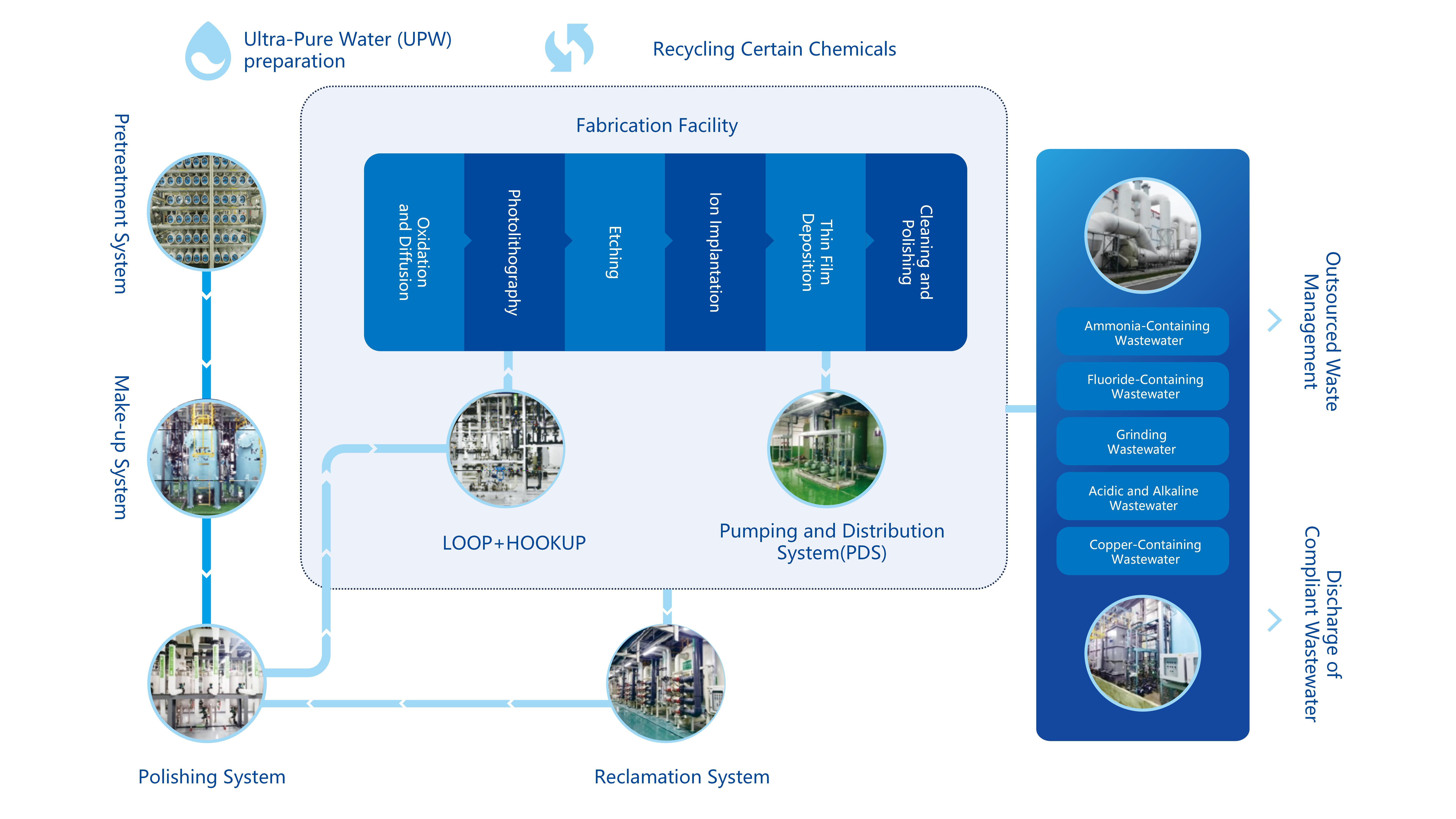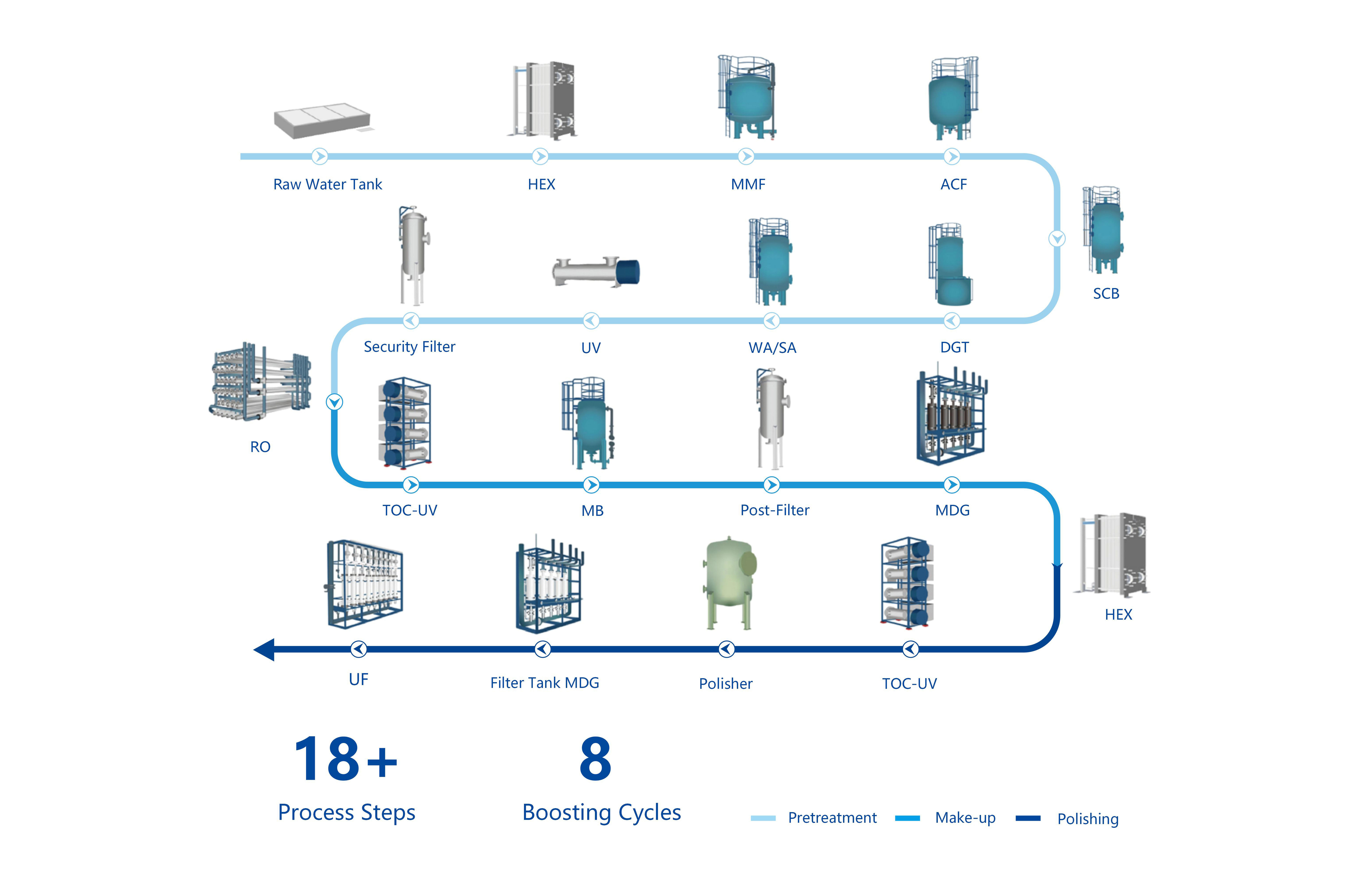Gaopin Tech is dedicated to providing the first-class UPW systems for semiconductor industry. Our business covers all aspects of UPW preparation, storage, distribution, collection, treatment and reuse, fulfilling every application of UPW throughout all semiconductor processes in FAB.
 To provide customers with first-class UPW and recycling solutions and equipment
To provide customers with first-class UPW and recycling solutions and equipment

 The standards for UPW in the semiconductor industry are exceptionally high
The standards for UPW in the semiconductor industry are exceptionally high
01 / Resistivity at 25°C ≥ 18.24MΩ·cm
02 / Total organic carbon < 0.5μg/L
03 / Dissolved oxygen < 1μg/L
04 / Particles larger than 0.05 micrometers < 100/L
05 / Bacterial content < 1/100 mL
06 / Total silicon content < 0.5μg/L
07 / Dissolved silicon content < 0.3μg/L
08 / Boron content < 0.005μg/L
 The UPW preparation process is extremely intricate
The UPW preparation process is extremely intricate
It involves multiple disciplines such as physics, chemistry, photochemistry, mechanics, aerodynamics, hydromechanics, and more.
It utilizes a variety of process technologies such as multimedia filtration, activated carbon adsorption, ion exchange, RO membrane, UV for disinfection, UV for TOC destruction, electrodialysis, ultrafiltration, nanofiltration, vacuum degassing towers, membran e degassing, and more.
18+ patented processing steps 8 boosting elevations

Through our seasoned technical team and continuous R&D investment and process exploration, our UPW systems achieve purity at the ppt level, with ion content at only part per trillion, breaking the foreign manufacturers’ monopoly in Chinese high-end UPW systems. We are one of the very few Chinese companies capable of providing UPW systems for the chip industry, and the first Chinese UPW integrator for 12-inch 14nm chip production lines.
UPW preparation involves the near-complete removal of impurities from water, which typically include particulates, electrolytes, organics, microorganisms, and dissolved gases. To purify municipal water supplies into UPW that meets the stringent standards required for chip manufacturing requires multiple treatment stages. Generally, an UPW preparation system is divided into three subsystems: pretreatment, make-up, and polishing.

A Pretreatment
Pretreatment, the first-level water preparation system, is designed based on the raw water quality and system scale. It removes particles larger than 5nm, including oxides, organics, and primary ions, and softens the water. This reduces the load on subsequent treatment units, ensuring the stability and efficiency of the overall treatment system. Pretreatment typically primarily uses filtration, ion exchange, UV irradiation, and reverse osmosis. The details are as follows.
|
Treatment process
|
Technical key pkoints
|
|
Filtration
|
The pretreatment system removes particles, oxides, and some organics through multimedia filters (MMF) and activated carbon filters (ACF), among others. The operation of multimedia filters can monitored with a Silt Density Index (SDI) instrument, and the operation of activated carbon filters is based on measurements from a residual chlorine meter. The selection of filter media specifications, quantity, and filtration rate control are key to optimizing the filtration results.
|
|
Ion exchange
|
Ion exchange in pretreatment is generally accomplished through a system comprising a cation bed, carbon dioxide degassing unit, and anion bed (2B3T). This unit functions as the first stage demineralizer in the pretreatment phase. The upstream water flows through a series of pressure vessels filled with cation and anion resins, replacing most of the ions in the tap water. The exhausted ion exchange resins are regenerated with acid and alkali to restore their exchange capacity, thereby ensuring continuous system operation. The carbon dioxide degassing unit removes carbon dioxide (CO2) produced from the reaction of hydrogen ions (H+) generated by the cation bed with carbonate (CO32-) and bicarbonate ions (HCO3-) in the water. This process reduces the load on the anion bed, ensuring the stability and continuity of the final treated water. The balance between operational efficiency and cost lies in selecting an appropriate bed type and operating time based on the distribution characteristics of cations and anions in the raw water.
|
|
UV irradiation
|
A 254nm UV light generator is used for UV irradiation, utilizing the properties of UV to inhibit bacterial growth and eliminate microorganisms in the water, which could affect the operation of subsequent equipment, further preventing potential microbial contamination. The critical aspects of UV irradiation involve the intensity and duration of UV exposure based on specific water quality parameters.
|
|
RO
|
Reverse osmosis systems involves reverse osmosis membranes, pressure vessels, piping, and instruments, all of which are designed according to certain principles. Its fundamental principle relies on selective permeation of membranes to separate ions and water molecules on either side of the membrane under pressure, thus concentrating ions on the brine side and achieving further deionization on the permeate side. Reverse osmosis can significantly extend the life of subsequent deionization equipment and save a substantial amount of chemical consumption.
|
B Make-up
Make-up serves to further improve water quality before it enters the final polishing stage, ensuring that the levels of organics, particulates, and specific solutes meet or approach the quality requirements of UPW. The make-up system primarily includes UV irradiation, ion exchange through mixed-bed, and membrane degassing. After the make-up, the water quality reaches a high degree of purity. The specific processes within the make-up system are as follows.
|
Treatment process
|
Technical key pkoints
|
|
UV irradiation
|
The main purpose of UV irradiation in the make-up system is to reduce Total Organic Carbon (TOC). TOC UV utilizes 185nm UV energy and hydroxyl radicals (OH-) from water molecule decomposition to break down organics into carbon dioxide and water molecules, thus effectively removing organics from the water. The critical aspects of UV irradiation involve adjusting the intensity and duration of UV exposure based on specific water quality parameters.
|
|
Ion exchange through mixed-bed
|
Ion exchange in the make-up system is primarily achieved through a mixed bed, which is a pressure vessel filled with both cation and anion resins. Its main function is to facilitate the exchange of ions in the water with the H+ and OH- groups on the resins. This process adsorbs cations and anions onto the resin, while the released H+ and OH- combine to form H2O, producing further purified deionized water with a typical resistivity of over 18 megaohms. The exhausted resins restore their exchange capacity through acid-alkali regeneration.
|
|
Membrane degassing
|
The deoxygenation membrane is a specialized membrane with unique pores that allow gas molecules (O2) in the water to pass through while preventing water molecules from doing so, thereby separating oxygen from the water. By adjusting the different vacuum levels and purities of sweep gases, the concentration of dissolved oxygen is controlled in accordance with Henry’s Law and Dalton’s Law, achieving the targeted trace levels.
|
C Polishing
The UPW polishing system is positioned at the final stage of UPW preparation. It utilizes additional UV irradiation, ion exchange through mixed-bed, membrane degassing, and precision filtration to further enhance water quality. High-quality polishing resins and high-performance separation membranes are employed to achieve refined water with consistent temperature, pressure, and quality. Due to the highly reactive nature of UPW, which cannot be stored statically, the UPW produced in the polishing system must be continuously purified in a circulation loop to maintain its purity until it is used. The specific processing techniques of the polishing system are as follows.
|
Treatment process
|
Technical key points
|
|
UV irradiation in polishing
|
The working principle is similar to the TOC UV during deionized water production, aiming to further reduce the TOC to 0.5ppb.
|
|
Ion exchange through mixed-bed in polishing
|
Disposable ion exchange resins are used, along with flow rate selection and control, to remove ions from the upstream water. Different types of resins are selected depending on the specific water quality requirements to meet the final specifications, including resistivity and control of weak acidic ions, such as silica and boron ions.
|
|
Membrane degassing in puolishing
|
The functions and principles are the same as those of the make-up system. This process is used at the polishing stage to meet the most stringent dissolved oxygen targets for UPW.
|
|
Terminal
ultrafiltration
|
The specially manufactured ultrafiltration membrane removes particles with a molecular weight greater than 4,000 Dalton, thus ultimately achieving control of the particle index of the terminal UPW.
|
 To provide customers with first-class UPW and recycling solutions and equipment
To provide customers with first-class UPW and recycling solutions and equipment
 The standards for UPW in the semiconductor industry are exceptionally high
The standards for UPW in the semiconductor industry are exceptionally high



